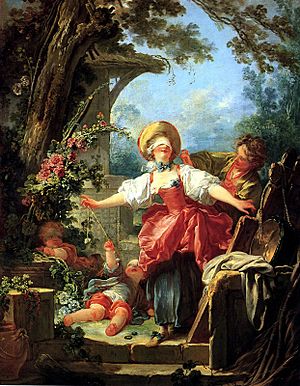Blind Man's Bluff facts for kids
Blind Man's Bluff is a famous oil painting created by the French artist Jean-Honoré Fragonard. He painted it between 1755 and 1756. This artwork is quite large, measuring about 46 by 36 inches (117 by 91 cm). Today, you can see it displayed at the Toledo Museum of Art in Ohio, USA. It is often considered a partner piece to another of Fragonard's paintings, The See-Saw, as both show similar playful scenes.
Contents
What is Blind Man's Bluff About?
This painting captures a fun moment from a popular game called "blind man's bluff." In the game, one person is blindfolded and tries to catch others. Fragonard's painting shows a group of young people playing this game in a beautiful, natural setting.
The Scene in the Painting
The artwork shows a young woman, blindfolded, reaching out to find her friends. Around her, other young people are laughing and trying to avoid being caught. The scene feels lively and full of energy. Fragonard was known for painting such joyful and lighthearted moments.
Colors and Light in the Artwork
Fragonard used bright, soft colors in Blind Man's Bluff. He also used light in a special way to make the figures stand out. The sunlight seems to filter through the trees, creating a warm and inviting atmosphere. This style was very popular during the Rococo period, which was a time when art focused on elegance and charm.
Who Was Jean-Honoré Fragonard?
Jean-Honoré Fragonard was a very important French painter from the 18th century. He was born in 1732 and lived until 1806. He is famous for his lively and often playful paintings.
Fragonard's Early Life and Training
Fragonard began his art studies at a young age. He learned from famous artists like Jean-Baptiste-Siméon Chardin and François Boucher. These teachers helped him develop his unique style, which was full of movement and bright colors. He even won a special prize that allowed him to study art in Rome, Italy.
What Kind of Art Did Fragonard Make?
Fragonard is best known for his Rococo style paintings. These often showed scenes of love, fun, and everyday life among wealthy people. His artworks usually have a light, airy feeling. He painted portraits, landscapes, and many scenes of people enjoying themselves, like in Blind Man's Bluff. His paintings are still admired today for their beauty and charm.
Where Can You See Blind Man's Bluff?
The painting Blind Man's Bluff is a treasured piece in the Toledo Museum of Art. This museum is located in Toledo, Ohio, in the United States. It has a large collection of art from different periods and places around the world.
The Toledo Museum of Art's Collection
The Toledo Museum of Art is a great place to explore art. Besides Fragonard's painting, it features works by many other famous artists. Visiting museums like this helps us understand art history and appreciate different cultures.
Why is This Painting Important?
Blind Man's Bluff is important because it shows us what life and art were like in 18th-century France. It captures the spirit of the Rococo period, which was all about beauty, pleasure, and lightheartedness.
Understanding the Rococo Art Style
The Rococo style was popular in Europe, especially in France, during the 18th century. It followed the more serious Baroque style. Rococo art is known for:
- Light colors and delicate designs.
- Playful and romantic themes.
- Lots of curves and fancy decorations.
- A focus on happiness and fun.
Fragonard was one of the greatest artists of this style.
The Legacy of Fragonard's Art
Fragonard's paintings, including Blind Man's Bluff, continue to be loved for their beauty and the joyful feelings they create. They offer a glimpse into a time when art celebrated elegance and the simple pleasures of life. His work influenced many artists who came after him.


